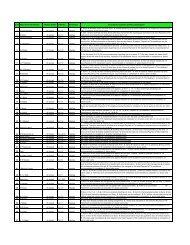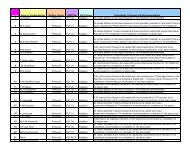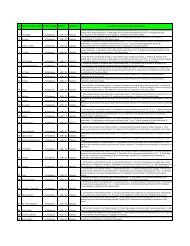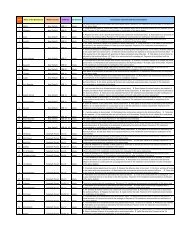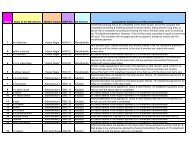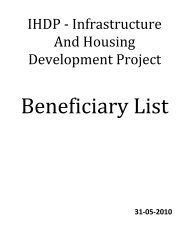Project Appraisal Document - IHDP
Project Appraisal Document - IHDP
Project Appraisal Document - IHDP
- No tags were found...
Create successful ePaper yourself
Turn your PDF publications into a flip-book with our unique Google optimized e-Paper software.
STRATEGIC CONTEXT AND RATIONALECountry and Sector Issues1. The twenty five year civil conflict in Sri Lanka led to a loss of life, the displacement ofpersons belonging to all ethnic groups and destruction to infrastructure. Approximately 2.5million persons lived in areas of direct military activity. Up to 700,000 left the country while613,220 individuals (160,754 families) remained internally displaced as at June, 2002 1 . 172,000internally displaced persons (IDPs) lived in refugee camps 2 that year. A cease-fire agreement wassigned in February, 2002.2. Many IDPs had returned to their places of origin since 2002. However, 68,000individuals (18,000 families) remained in refugee camps in Sri Lanka in December 2005. Therecent escalation of violence since January, 2006 led to renewed displacement withapproximately 235,000 new IDPs in Sri Lanka. The District of Puttalam in the north west of SriLanka housed most of the remaining earlier IDPs. 63,145 persons (or 15,480 families) lived in141 refugee camps in Puttalam in 2006. 41% of the Puttalam IDPs are children under the age of18 who have known no other home than Puttalam. 96% of the IDPs there (14,928 families)indicated that they intended to settle down in Puttalam and not return to the North given securityconsiderations 3 . 74.2% had in fact bought land in Puttalam demonstrating a resolve to remainthere.3. The IDPs in Puttalam were displaced in 1990. 5,653 families live in temporary thatchedhouses, 2,232 families live in partly-completed houses and 1,093 families live in permanenthouses 4 . 6,501 families, who are largely the married children of the original displaced in 1990,have no house of their own. They live with their extended families. 12,154 new houses and 2,232part-constructions are therefore required to address the housing needs of the Puttalam IDPs. Therefugee camps lack access to safe drinking water, sanitation, drainage, health care and education.These too are needed to ensure a durable solution to their predicament 16 years afterdisplacement. Of the 111 refugee camps surveyed under the Social Assessment (SA), 86 campshad listed housing as their highest priority while 13 listed it as the second highest priority.1 Figure excludes those who had been displaced in the 1980s and 1990s and had since returned to theirhomes.2 The word used in Sri Lanka is welfare center but for purposes of this document, the more recognizableterm refugee camp would be used.3 These figures were obtained from a United Nations High Commissioner for Refugees (UNHCR)supervised census of refugee camps in Puttalam in April, 2006. Most of the Puttalam IDPs are Muslim andwere expelled by the LTTE from the North East in October 1990. Depending on their place of origin, theywere compelled to leave their homes within 2 hours, 48 hours or one week. Their lack of desire to returncompares starkly with the overall number of returnees to the North East until the recent resumption ofhostilities.4 Permanent houses are defined as those with completed structure and finishing, partly-completed housesare defined as needing significant home improvement, and temporary houses are defined as thatched hutswith flimsy superstructure.5



